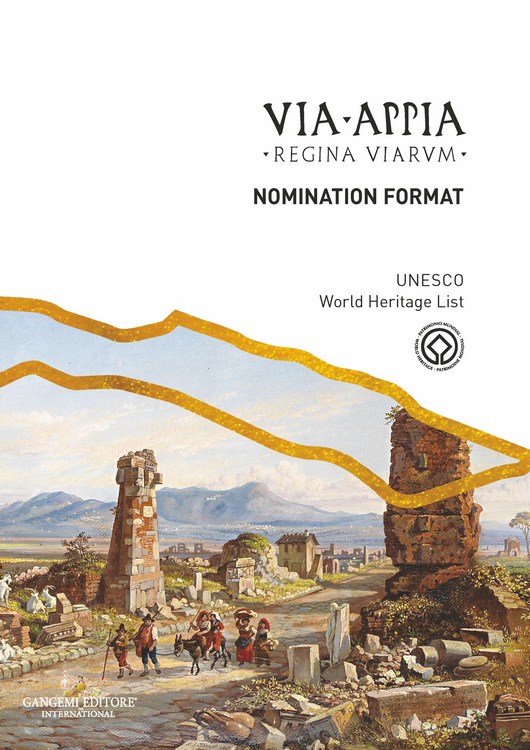
Fuori commercio
Via Appia
Regina Viarum
A cura di: Ministero della Cultura
Full English text
Formato: 21 x 29,7 cm
Legatura: Filorefe
Pagine: 1528
Anno edizione: 2024
ISBN: 9788849245882
EAN: 9788849245882
UB. INT. :
Contenuto
Roman roads are among Rome’s most long-lasting monuments: the great paved roads run all over the thenknown world, crossing mountains and swamps, even the heart of the Sahara, with wondrous confidence, to connect the most remote parts of the Empire. The viae romanae (Roman roads) were built following precise designs and exceptional techniques so that they were solid and durable, and they really are a factor of immeasurable importance in the history of mankind; the Via Appia, together with the other Roman roads, has had a universal impact on the movement of people, goods, ideas, beliefs and religions through the centuries, not least because it was conceived as a via publica (public road) to be used by all citizens for free.
On the Via Appia, therefore, millennia of history overlapped and flowed, as the number and value of surviving monuments along it also testify. Its importance was already strongly felt in Antiquity, so much so that not only Via Appia has been mentioned in the work of many classical writers, but it was even celebrated as ‘regina viarum’ (queen of all roads) by the poet Statius (Silvae, II, 2, 12) and Martial dedicated a famous line to it: ‘O Appian way, …, the most celebrated of Italian roads’ (Epigrammaton libri, IX, 101).
The Italian Ministry of Culture decided to propose the ‘Via Appia. Regina Viarum’, including the bypass road Appia Traiana, for the inscription on the World Heritage List because it bears a unique exceptional testimony to the Roman civilization. Furthermore, as part of the Italian national archaeological heritage, the Via Appia is subject – by law – to the requirements of the Italian protection law and regulations and when it is brought to light it enters the State property. For the purposes of nomination, a Scientific Commission has been established – with distinguished members from the cultural world who contributed to the knowledge, protection and enhancement of the ancient road – and also a Technical-Scientific Committee – composed of authoritative academics and Ministry officials – that coordinated the preparation of the required documentation to propose the inscription of the site on the World Heritage List. The large number of Institutions, Authorities and local community representatives accounts for the complex participatory process conducted. The Via Appia is proposed as a serial site, and its 22 carefully selected component parts contribute – with their attributes still existing and alive – to conveying its Outstanding Universal Value.
The nomination format is accompanied by the documentary ‘Via Appia. Regina Viarum’ made by RAI Radiotelevisione Italiana in collaboration with the Ministry of culture.
It is part of the nomination documentation Mappia – Map(of Ap)pia – a work by Roberto Paci Dalò. The artist and cartographer has created a map of more than 9 meters wide in leporello format. In the work, inspired by the Tabula Peutingeriana, the paths of the Via Appia and the Via Appia Traiana appear stylized, associating them with a series of places, technologies, architectures, historical, artistic and cultural events that are depicted through drawing, looking in particular at medieval miniatures such as the Byzantine, Persian, Armenian, and Chinese ones. In this way, the artist has combined the practices of the scribe and the miniaturist of amanuensis monks’ memory in his work. A journey that highlights salient events and people who appeared over twenty-three centuries reaching the present day and showing all the vitality, and the extraordinariness, of the Regina Viarum.
The work consists of six volumes, with a combined total of 1528 pages:
- Nomination Format
- Executive Summary
- Annex 1 – Scientific Insights
- Annex 2 – Code of the cultural and landscape heritage – Memorandum of understanding
- Annex 3 – Management Plan
- Annex 4 – Boundaries Insights
Component parts and bodies involved (Region(s), Province(s), Municipality(ies)):
- The Via Appia in Rome, from the 1st to the 13th mile
Lazio Region – Metropolitan city of Rome – Roma Capitale, Municipality of Ciampino, Municipality of Marino - The Via Appia across Alban Hills
Lazio Region – Metropolitan city of Rome – Municipality of Castel Gandolfo, Municipality of Albano Laziale, Municipality of Ariccia - The Via Appia from the 19th to the 24th mile, with a branch to Lanuvium
Lazio Region – Metropolitan city of Rome – Municipality of Genzano di Roma, Municipality of Nemi, Municipality of Lanuvio, Municipality of Velletri - The Via Appia in the Pontine Plain, with a branch toNorba
Lazio Region – Province of Latina – Municipality of Cisterna di Latina, Municipality of Latina, Municipality of Norma, Municipality of Sermoneta, Municipality of Sezze, Municipality of Pontinia, Municipality of Terracina - Tarracina and the crossing of the Lautulae Pass
Lazio Region – Province of Latina – Municipality of Terracina, Municipality of Monte S. Biagio - The Via Appia in Fundi
Lazio Region – Province of Latina – Municipality of Fondi - The Via Appia at the Itri Pass
Lazio Region – Province of Latina- Municipality of Fondi, Municipality of Itri - The Via Appia from 83rd mile to Formiae
Lazio Region – Province of Latina – Municipality of Itri, Municipality of Formia, Municipality of Gaeta - Minturnae and the Garigliano crossing
Lazio Region, Campania Region – Province of Latina, Province of Caserta – Municipality of Minturno, Municipality of Sessa Aurunca - The Via Appia from Sinuessa to the pagus Sarclanus
Campania Region – Province of Caserta – Municipality of Sessa Aurunca, Municipality of Mondragone - Ancient Capua
Campania Region – Province of Caserta – Municipality of S. Maria Capua Vetere - Beneventum and the Arch of Trajan
Campania Region – Province of Benevento – Municipality of Benevento - The Via Appia on the route from Beneventum to Aeclanum
Campania Region – Province of Benevento, Province of Avellino – Municipality of Benevento, Municipality of S. Giorgio del Sannio, Municipality of S. Nicola Manfredi, Municipality of Calvi, Municipality of Apice, Municipality of Venticano, Municipality of Bonito, Municipality of Mirabella Eclano - The Via Appia in the upper Bradano Valley
Basilicata Region – Province of Potenza – Municipality of Melfi, Municipality of Rapolla, Municipality of Venosa, Municipality of Palazzo S. Gervasio, Municipality of Banzi, Municipality of Genzano di Lucania - The Via Appia on the “tarantino” sheep-track
Puglia Region
Basilicata Region – Metropolitan city of Bari, Province of Matera – Municipality of Altamura, Municipality of Santeramo in Colle, Municipality of Matera, Municipality of Laterza, Municipality of Castellaneta - Tarentum
Puglia Region – Province of Taranto – Municipality of Taranto - The Via Appia from Mesochorum to Scamnum
Puglia Region – Province of Taranto, Province of Brindisi – Municipality of Grottaglie, Municipality of Francavilla Fontana, Municipality of Oria, Municipality of Latiano, Municipality of Mesagne - Brundisium
Puglia Region – Province of Brindisi – Municipality of Brindisi - The Appia Traiana from Beneventum to Aequum Tuticum
Campania Region – Province of Benevento, Province of Avellino – Municipality of Benevento, Municipality of Paduli, Municipality of Sant’Arcangelo Trimonte, Municipality of Buonalbergo, Municipality of Casalbore, Municipality of Montecalvo Irpino, Municipality of Ariano Irpino - The Appia Traiana from Aecae to Herdonia
Puglia Region – Province of Foggia, Province of Barletta-Andria-Trani – Municipality of Troia, Municipality of Foggia, Municipality of Castelluccio dei Sauri, Municipality of Ascoli Satriano, Municipality of Ordona - The Appia Traiana at Canusium and the Ofanto course
Puglia Region – Province of Barletta-Andria-Trani – Municipality of Cerignola, Municipality of Canosa di Puglia, Municipality of San Ferdinando, di Puglia, Municipality of Barletta, Municipality of Trinitapoli, Municipality of Margherita di Savoia - The Appia Traiana along the Adriatic coast, through Egnatia
Puglia Region – Metropolitan city of Bari, Province of Brindisi – Municipality of Monopoli, Municipality of Fasano, Municipality of Ostuni, Municipality of Carovigno, Municipality of Brindisi
Parole chiave
Condividi su

